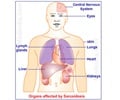Researchers in a recent study have identified how metal beryllium triggers a deadly immune response in the lungs.

Not everyone who works with the metal becomes ill. About 85 percent of people who develop chronic beryllium disease have an immune system protein known as HLA-DP2. Cells throughout the body use this molecule to tell the immune system what is going on inside of them. HLA-DP2 sits on the cell surface holding small protein fragments taken from the cell's interior. Immune system sentinels known as T cells bump against HLA-DP2 and its displayed protein fragment. If the protein fragment is derived from the body's own proteins, the T cell ignores it; if it is a foreign peptide, say from a bacterium, virus or other pathogen, the T cell sounds the alarm and triggers an immune response. HLA-DP2 differs from most other peptide-presenting proteins by a single amino acid.
Dr. Kappler and his colleagues performed a series of highly detailed genetic, x-ray diffraction, molecular binding and electrostatic studies to show how this single amino acid can combine with other amino acids from HLA-DP2 and some of its bound self-peptides to create a unique molecular pocket that captures a single beryllium ion along with a sodium ion. The peptides that bind to HLA-DP2 come from the body's own tissues and normally elicit no immune response. With the beryllium and sodium firmly lodged in the molecular pocket, however, those peptides have a very slightly altered shape and electrical charge, which roving T cells recognize as foreign and dangerous. They initiate an immune response that causes inflammation and scarring in the lungs. "This response resembles allergic hypersensitivity in that a metal ion causes an allergic reaction," said Dr. Kappler. "But it also resembles autoimmunity in that the immune system is mounting an attack against a self-peptide. It is a new form of immune response, and may lead to new therapeutic strategies to treat and prevent the disease."
Source-Eurekalert












